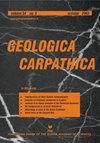Zirconian–niobian titanite and associated Zr-, Nb-, REE-rich accessory minerals: Products of hydrothermal overprint of leucocratic teschenites (Silesian Unit, Outer Western Carpathians, Czech Republic)
IF 1.5
4区 地球科学
Q4 GEOSCIENCES, MULTIDISCIPLINARY
引用次数: 4
Abstract
Sills of hydrothermally altered alkaline magmatic rock (teschenite) of Lower Cretaceous age at the Čerťák and Řepiště sites in the Silesian Unit (Flysch Belt of the Outer Western Carpathians, Czech Republic) host leucocratic dykes and nests which contain accessory minerals enriched in Zr, Nb and REE: Zr-, Nb-rich titanite, zircon, gittinsite, pyrochlore, monazite, REE-rich apatite, epidote, and vesuvianite. Titanite forms wedge-shaped crystals or irregular aggregates enclosed in the analcime groundmass or overgrowths on Zr-rich ferropargasite and taramite or Zr-rich aegirine–augite to aegirine. Titanite crystals show oscillatory or irregular patchy to sector zoning and contain up to 17.7 wt. % ZrO2 and 19.6 wt. % Nb2O5, and ≤1.1 wt. % REE2O3. High-field-strength elements (HFSE) are incorporated into the structure of the studied titanite predominantly by substitutions: (i) [6]Ti4+ ↔ [6]Zr4+; (ii) [6]Ti4+ + [6]Al3+ ↔ [6]Zr4+ + [6]Fe3+; and (iii) [6]2Ti4+ ↔ [6]Nb5+ + [6](Al, Fe)3+. Magmatic fractional crystallization, high-temperature hydrothermal autometasomatic overprint and low-temperature hydrothermal alterations resulted in the formation of the HFSE-rich mineral assemblages within the leucocratic teschenites. Autometamorphic processes caused by high-temperature hypersaline aqueous solutions (salinity ~50 wt. %, ~390–510 °C), which were released from the HFSE-enriched residual melt, played a major role in the crystallization of Zr-, Nb-, and REE-rich minerals. The mobilization of HFSE could have occurred either by their sequestration into a fluid phase exsolved from the crystallizing melt or by superimposed alteration processes. The distinctive positive Eu anomaly (EuCN/Eu* = 1.85) of leucocratic dykes infers possible mixing of Eu2+-bearing magmatic fluids with more oxidized fluids.氧化锆-铌钛酸盐和相关富含Zr、Nb、REE的副矿物:隐色特申岩热液叠加产物(西里西亚单元,外西喀尔巴阡山脉,捷克共和国)
西里西亚单元(捷克喀尔巴阡山脉西部外缘的复理石带)Čerťák和Řepiště处下白垩世热液蚀变碱性岩浆岩(特氏岩)的岩穴中赋有富含Zr、Nb和REE的白岩脉和岩穴,其中含有富Zr、富Nb的钛矿、锆石、闪质、焦绿石、独辉石、富REE磷灰石、绿柱石和维苏岩等副矿物。钛矿形成楔形晶体或不规则聚集体包裹在铝矿基质中,或过度生长在富锆铁长辉石和石矾石或富锆铝辉石和铝辉石上。钛矿晶体显示振荡或不规则的块状或扇形带,含有高达17.7 wt. %的ZrO2和19.6 wt. %的Nb2O5,以及≤1.1 wt. %的REE2O3。高场强元素(HFSE)主要通过替换并入所研究的钛矿结构中:(i) [6]Ti4+↔[6]Zr4+;(ii) [6]Ti4+ + [6]Al3+↔[6]Zr4+ + [6]Fe3+;(iii) [6]Nb5+ + [6](Al, Fe)3+。岩浆分异结晶、高温热液自动套印和低温热液蚀变作用形成了富氟铁铁矿物组合。富hfse残余熔体释放的高温高盐水溶液(盐度~50 wt. %, ~390 ~ 510℃)引起的自变质作用对富Zr-、Nb-和ree矿物的结晶起主要作用。HFSE的动员可能是由于它们从结晶熔体中分离到流体相中或通过叠加蚀变过程而发生的。白质岩脉明显的正Eu异常(EuCN/Eu* = 1.85)推断含Eu2+岩浆流体可能与更多氧化流体混合。
本文章由计算机程序翻译,如有差异,请以英文原文为准。
求助全文
约1分钟内获得全文
求助全文
来源期刊

Geologica Carpathica
地学-地球科学综合
CiteScore
2.40
自引率
23.10%
发文量
26
审稿时长
>12 weeks
期刊介绍:
GEOLOGICA CARPATHICA covers a wide spectrum of geological disciplines including geodynamics, tectonics and structural geology, volcanology, stratigraphy, geochronology and isotopic geology, karstology, geochemistry, mineralogy, petrology, lithology and sedimentology, paleogeography, paleoecology, paleobiology and paleontology, paleomagnetism, magnetostratigraphy and other branches of applied geophysics, economic and environmental geology, experimental and theoretical geoscientific studies. Geologica Carpathica , with its 60 year old tradition, presents high-quality research papers devoted to all aspects not only of the Alpine-Carpathian-Balkanian geoscience but also with adjacent regions originated from the Mediterranean Tethys and its continental foreland. Geologica Carpathica is an Official Journal of the Carpathian-Balkan Geological Association.
 求助内容:
求助内容: 应助结果提醒方式:
应助结果提醒方式:


